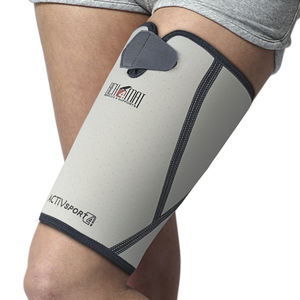
Hip orthosis AM-SB/1RE DUALarticulated

Add to favorites
Compare this product
fo_shop_gate_exact_title
Characteristics
- Type
- hip orthosis
- Options
- articulated
Description
The hip is the largest “ball-and-socket” joint in the body. It is held together by ligaments, tendons, and a joint capsule. The hip joint is created by femoral head (ball) and acetabulum (socket). They are cover by smooth articular cartilage. It provides smooth and painless movement. The labrum creates a seal of the hip joint and keeps a natural fluid called synovial fluid inside the hip joint.
Hip dysplasia means that the hip joint is the wrong shape, or that the hip socket is not in the correct position to completely cover and support the femoral head. It causes painful hip instability and asymmetric movements.
The first sign of hip dysplasia in an adolescent or young adult are typically hip pain and a limp. In rare cases, clicking and popping may be the presenting sign.
In medicine we use a number of different terms for hip dysplasia depending on severity and time of occurrence. These names include1:
Hip Dysplasia
Developmental Dislocation of the Hip (DDH)
Hip Dislocation
Developmental Dysplasia of the Hip (DDH)
Acetabular Dysplasia
Congenital Dislocation of the Hip (CDH)
Non-treated hip dysplasia may causes advanced hip deformations and disability!
To reduce pain and risk of hip deformations, we introduced to our offer VIPERdual (AM-SB/1RE) – innovative bilateral hip brace with range of motion adjustment.
Product description
VIPERdual brace stabilizes hips and provides immobilization o range of motion adjustment in every 15 degrees.
VIDEO
Catalogs
No catalogs are available for this product.
See all of Reh4Mat‘s catalogsRelated Searches
- Orthopedic immobilization
- L orthopedic immobilization
- S orthopedic immobilization
- M orthopedic immobilization
- XL orthopedic immobilization
- Support belt
- Adult support belt
- Articulated orthopedic immobilization
- XXL orthopedic immobilization
- Knee orthosis
- M support belt
- L support belt
- S support belt
- XL support belt
- Semi-rigid support belt
- Open knee orthopedic immobilization
- XXL support belt
- Forearm support
- AFO
- Lumbar support belt
*Prices are pre-tax. They exclude delivery charges and customs duties and do not include additional charges for installation or activation options. Prices are indicative only and may vary by country, with changes to the cost of raw materials and exchange rates.

















